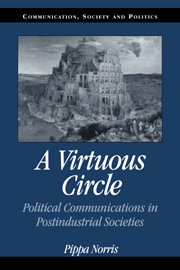Book contents
- Frontmatter
- Contents
- List of Tables
- List of Figures
- Preface
- PART I THE NEWS MEDIA AND CIVIC MALAISE
- PART II TRENDS IN POLITICAL COMMUNICATIONS
- 4 The Decline of Newspapers?
- 5 The Rise (and Fall?) of the Television Age
- 6 The Emerging Internet Era
- 7 The Evolution of Campaign Communications
- 8 The Rise of the Postmodern Campaign?
- PART III THE IMPACT ON DEMOCRACY
- CONCLUSIONS
- Technical Appendix
- Notes
- Select Bibliography
- Author Index
- Subject Index
8 - The Rise of the Postmodern Campaign?
Published online by Cambridge University Press: 26 February 2010
- Frontmatter
- Contents
- List of Tables
- List of Figures
- Preface
- PART I THE NEWS MEDIA AND CIVIC MALAISE
- PART II TRENDS IN POLITICAL COMMUNICATIONS
- 4 The Decline of Newspapers?
- 5 The Rise (and Fall?) of the Television Age
- 6 The Emerging Internet Era
- 7 The Evolution of Campaign Communications
- 8 The Rise of the Postmodern Campaign?
- PART III THE IMPACT ON DEMOCRACY
- CONCLUSIONS
- Technical Appendix
- Notes
- Select Bibliography
- Author Index
- Subject Index
Summary
To understand the implications of these developments and the longer-term changes in campaigning outlined in the preceding chapter, we can turn to detailed case studies of American and British elections in the mid-1940s, just prior to the rise of television and opinion polls, and compare them to campaigns in the 1990s. The techniques of modern campaigning probably have been transformed most radically in America, so a case study of U.S. presidential elections should highlight the extent of the changes and the outlines of the postmodern campaign that is emerging. Comparisons can be drawn with Britain, a country sharing strong cultural bonds with America, with important similarities in party and electoral systems, and therefore perhaps one of the countries most strongly influenced by transatlantic trends. The first section compares party organizations, news environments, and electorates in the 1948 U.S. and 1945 British elections as exemplars of premodern campaigning. The next section goes on to compare the situations in the 1996 American presidential election and the equivalent 1997 British general election and then considers the implications of these changes.
THE PREMODERN AMERICAN CAMPAIGN
The 1948 American presidential campaign represented the last hurrah for the old system. The Truman and Dewey campaign organizations still relied heavily on traditional face-to-face retail politics for getting out the message, with whistle-stop railway tours across the country, meetings with party notables, ticker-tape parades in major cities, and keynote speeches before packed crowds.
- Type
- Chapter
- Information
- A Virtuous CirclePolitical Communications in Postindustrial Societies, pp. 162 - 180Publisher: Cambridge University PressPrint publication year: 2000
- 1
- Cited by



